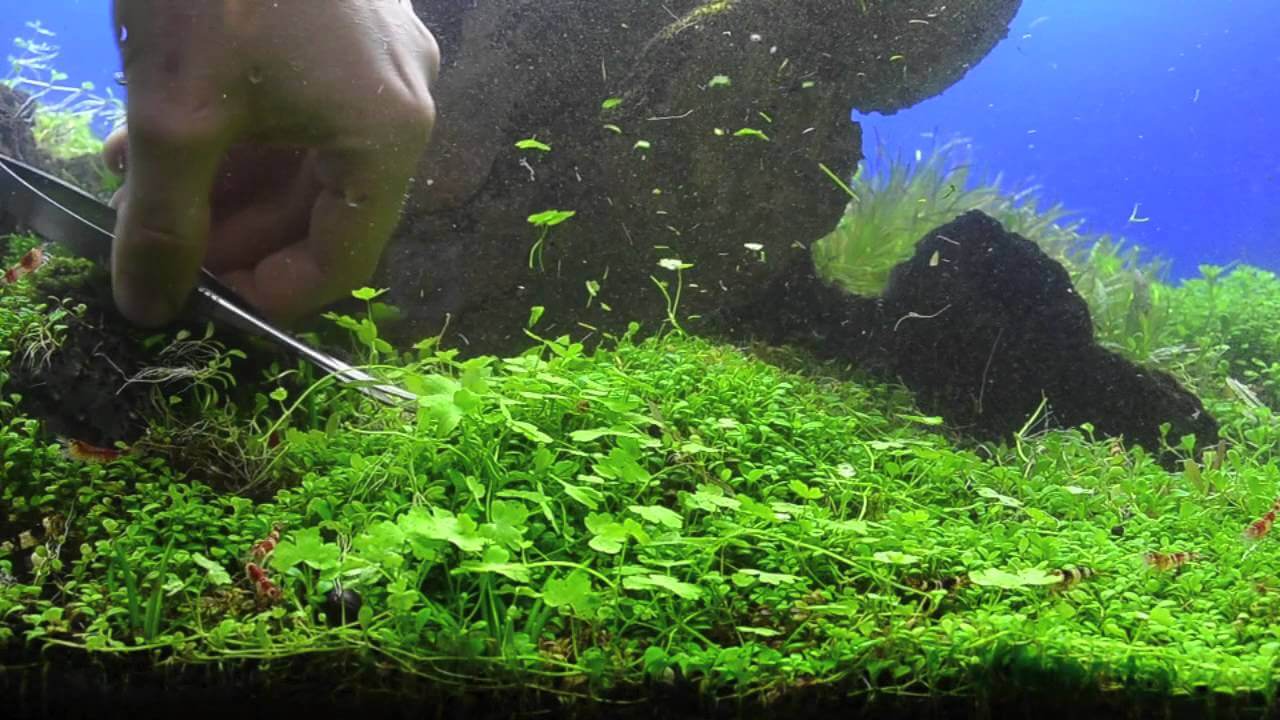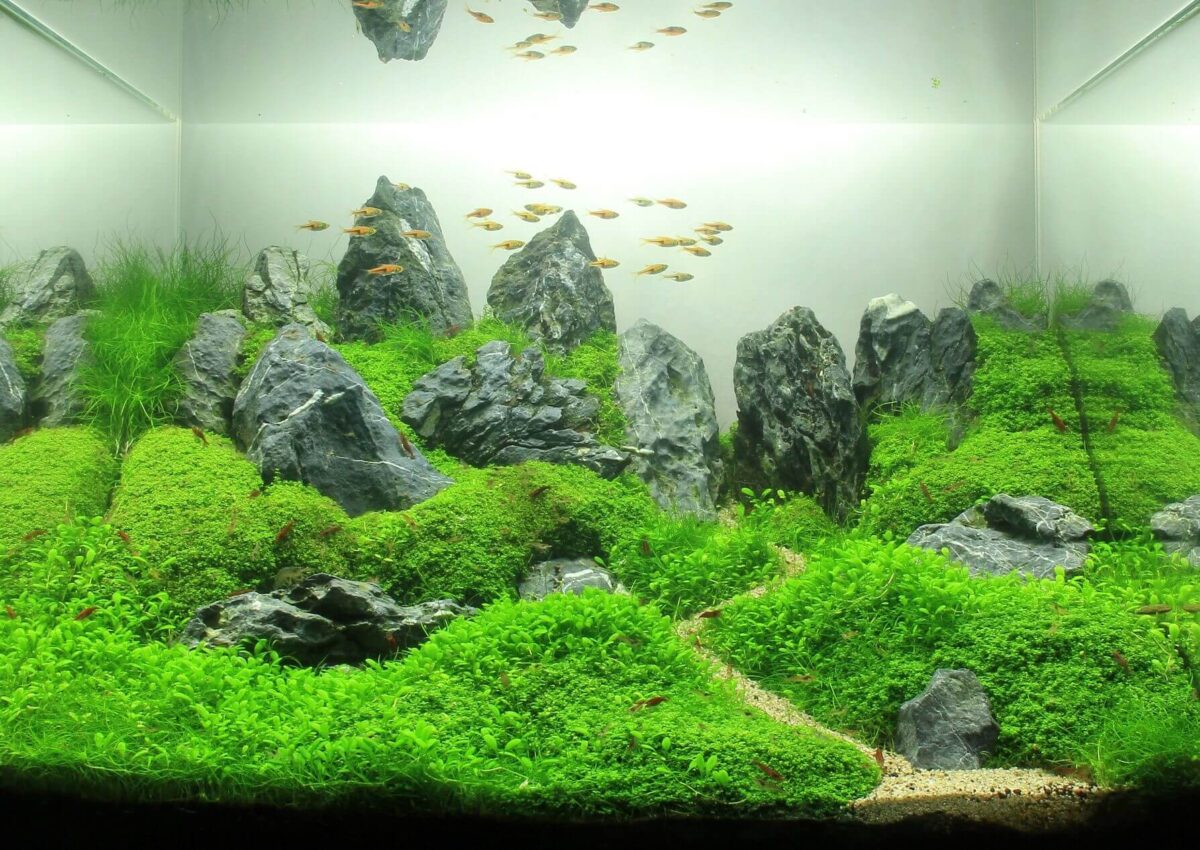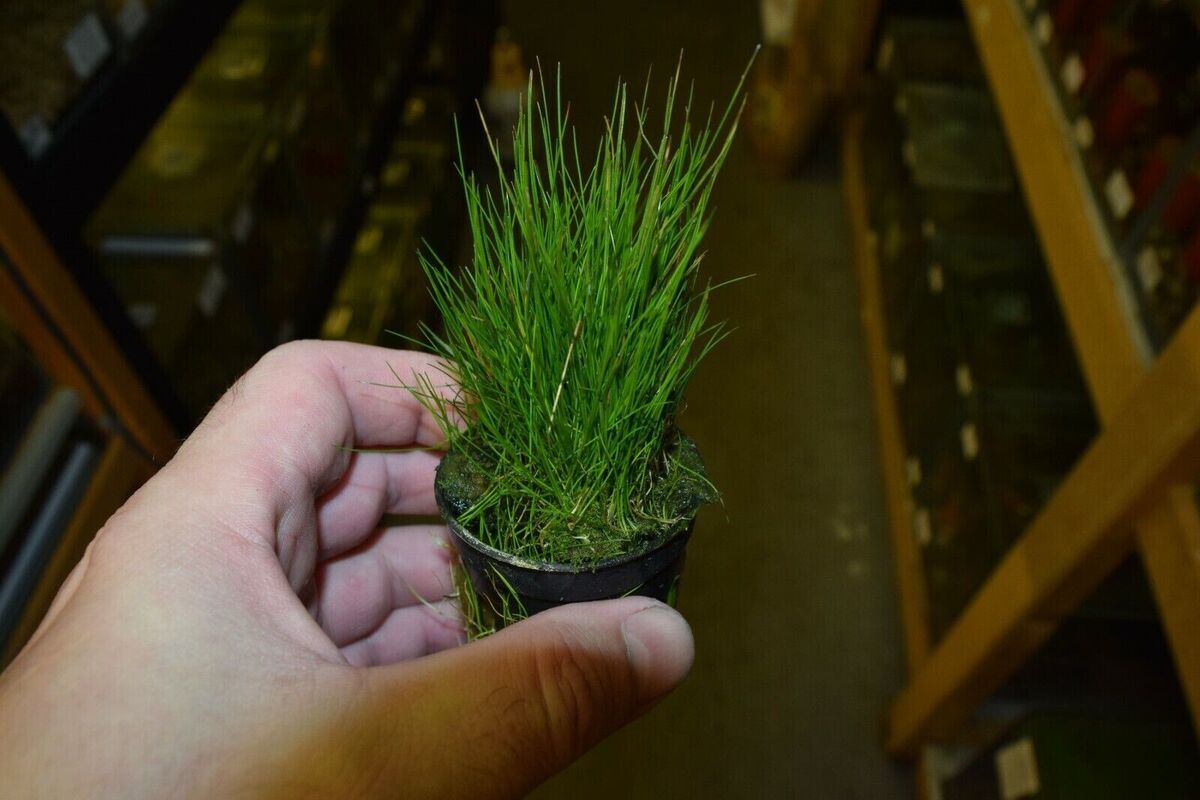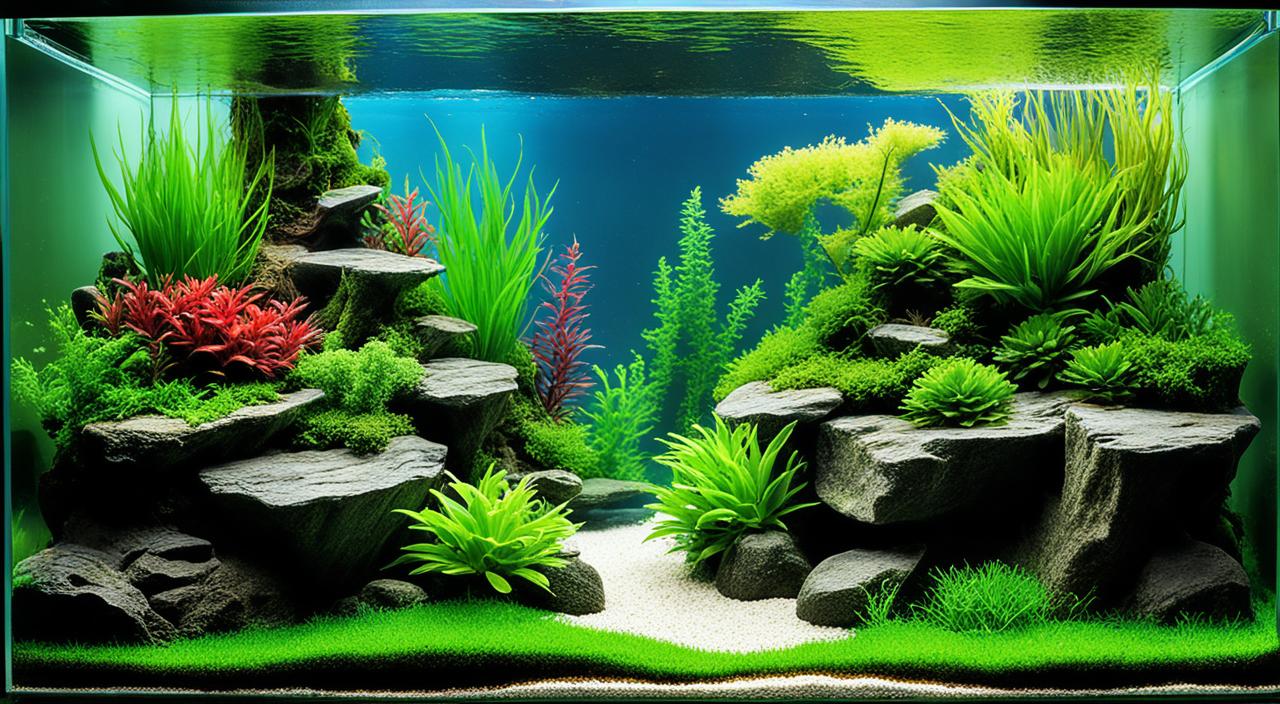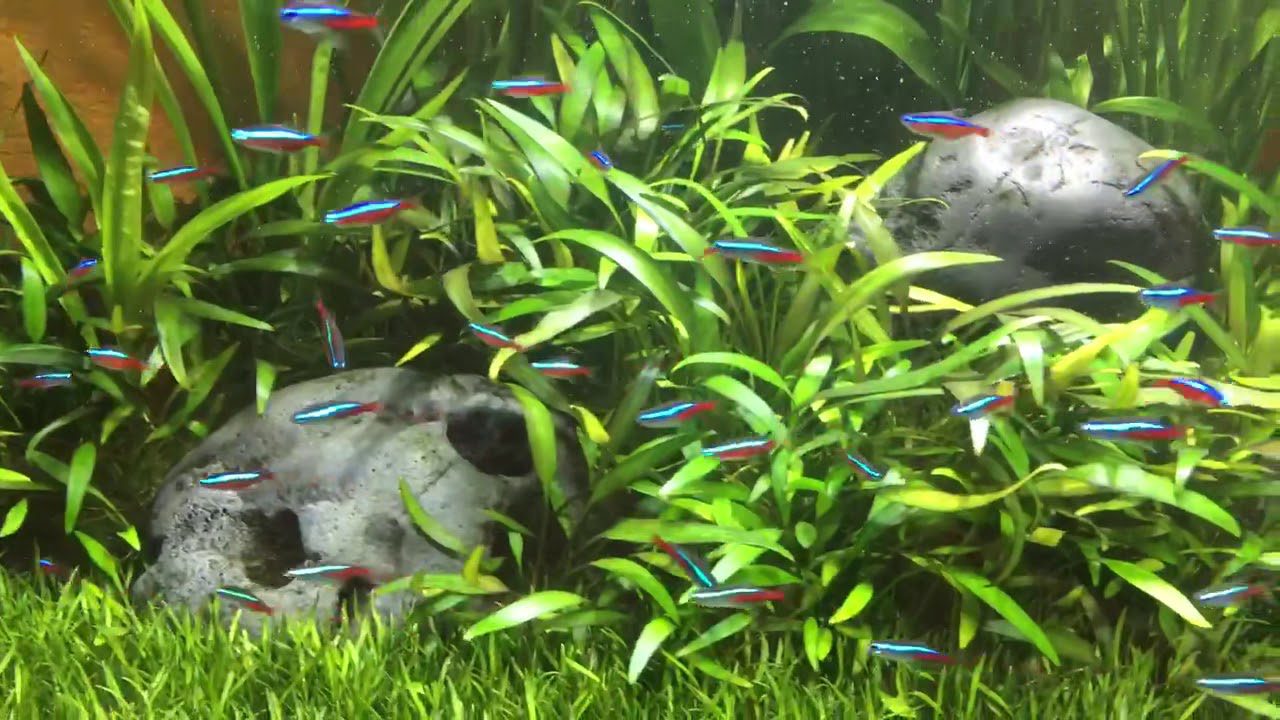Glossostigma elatinoides, or Glosso, is a highly sought-after aquarium plant that can transform any freshwater tank into a visually captivating underwater landscape. With its vibrant green foliage and ability to form dense carpets, Glosso is a favourite among aquascaping enthusiasts. However, it requires specific care and maintenance to thrive and reach its full potential.
As a high-light aquatic plant, Glosso demands adequate lighting conditions. It must be placed in a well-lit tank to support photosynthesis and prevent the plants from growing vertically. Additionally, CO2 supplementation is crucial for Glosso’s growth. Providing sufficient CO2 through either pressurized systems or DIY methods will help the plants flourish and maintain their low-growing carpeting form.
Aquascaping with Glossostigma elatinoides offers endless possibilities for creativity. Its ability to create a freshwater ground cover effect is ideal for building lush and captivating underwater landscapes. Whether you’re a beginner or an experienced aquascaper, Glosso is a versatile plant that can achieve stunning results in many ways.
In this guide, I’ll provide detailed information on glossostigma elatinoides care, including best practices for planting and propagating Glosso, ideal water parameters, and tips for maintaining its health and vitality. Following these guidelines, you can create a thriving aquarium with Glossostigma elatinoides as the show’s star.
So, let’s dive in and discover the secrets to caring for Glossostigma elatinoides!
Key Takeaways:
- Glossostigma elatinoides, or Glosso, is a highly sought-after carpeting aquarium plant.
- It requires high-light conditions and CO2 supplementation to thrive and maintain its low-growing form.
- Glosso is a versatile plant that can be used to create beautiful aquascapes.
- Proper planting and propagation techniques are essential for successful Glosso growth.
- Maintaining ideal water parameters and providing regular care will help ensure Glosso’s health and vitality.
Brief Overview Of Glossostigma elatinoides
Glossostigma elatinoides, also known as Glosso, is a popular choice among aquarists for its ability to create stunning carpeting effects in aquariums. It is one of the most miniature aquarium plants, reaching a maximum height of 2-3 cm. This makes it an excellent choice for foreground plants in small aquariums.
Glosso has round, vibrant green leaves that stand out against neutral-toned substrates. Its small size and low-growing nature make it an ideal choice for creating lush carpets in the front of an aquarium. Glosso can quickly spread and create a dense carpet effect with sufficient lighting and nutrient levels.
Glossostigma Elatinoides Information Table:
| Characteristics | Description |
|---|---|
| Scientific Name: | Glossostigma elatinoides |
| Common Names: | Glosso, Glossostigma |
| Origin: | Australia, New Zealand |
| Height: | 2-3 cm (0.8-1.2 inches) |
| Growth Rate: | Fast |
| Colour: | Bright green |
| Aquarium Placement: | Foreground as a carpet plant |
| Water Type: | Freshwater |
| pH: | 5.0 – 7.0 |
| Care Level: | Moderate to High |
| Light Requirements: | High (50-70 PAR, 5000-7000 Lux, Kelvin scale around 6500K-7000K for optimal growth) |
| CO2 Requirements: | High (CO2 injection recommended for lush growth and carpet formation) |
| Temperature: | 22-26°C (72-78°F) |
| Flow Rate: | Moderate (ensures nutrient distribution and prevents algae growth) |
| Propagation: | Runners (small daughter plants form and spread from the parent plant) |
| Feed Type: | Root tabs are beneficial; liquid fertilizers can be used for additional nutrients. |
The light requirements for Glossostigma elatinoides are pretty specific to ensure optimal growth. It thrives under high light conditions, with a PAR (Photosynthetically Active Radiation) value of 50-70, corresponding to around 5000-7000 Lux. The ideal Kelvin scale for the lighting is between 6500K and 7000K, which provides a spectrum that closely resembles natural daylight and supports healthy photosynthesis.
To keep Glosso low-growing and prevent it from growing vertically, it is vital to provide high lighting and CO2 injection in the aquarium. This will help maintain its compact and visually appealing appearance, enhancing the overall aesthetics of the tank.
With its dwarf size, low-growing habit, and stunning visual appeal, Glossostigma elatinoides is a must-have plant for aquascaping enthusiasts looking to create beautiful and captivating aquarium layouts.
Origins And Habitat
Glossostigma elatinoides, commonly known as Glosso, is a native aquatic plant of Australia, Tasmania, and New Zealand. It naturally thrives in various aquatic habitats, including bogs, flood areas, river banks, and lakeshores. In these native habitats, Glosso can grow both emersed and fully submerged, adapting to different water levels and conditions.
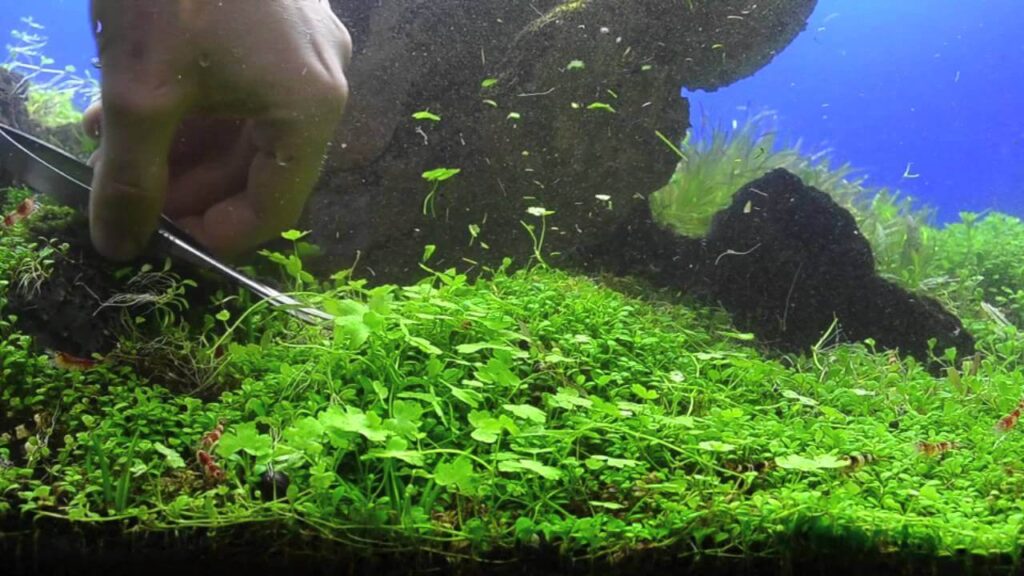
One of the reasons for Glosso’s popularity in the aquarium trade is its ability to create a beautiful visual impact. The plant requires ample sunlight and nutrient-rich water to thrive. It is often found in areas with sufficient sunlight penetration, such as shallow bays and edges of rivers and lakes.
Glossostigma elatinoides was introduced to the aquarium trade in the 1980s and quickly gained recognition for its aesthetic appeal. Its ability to form dense carpets of vibrant green foliage makes it a sought-after choice for aquascaping enthusiasts.
Morphological Characteristics
Glossostigma elatinoides, commonly known as Glosso, is a highly distinctive aquarium plant that stands out due to its unique morphological characteristics. Its appearance is defined by small, round leaves that exhibit vibrant, bright green colouration.
The shape of these leaves resembles a spatula, providing an interesting visual element to the plant. Another notable feature of Glosso is that it spreads through creeping runners, which allows it to form a dense and tightly knit carpet in aquariums.
The presence of two leaves per node sets Glosso apart from similar plants like Marsilea, which have alternate leaves with only one leaf per node. Additionally, Glosso leaves display a distinct midrib, while the veins of Marsilea have a fan-shaped pattern.
The image above showcases the characteristic appearance of Glossostigma elatinoides. Its small leaves and creeping runners contribute to forming a lush carpet in aquariums.
| Characteristics | Details |
|---|---|
| Leaf Shape | Spatula-like |
| Leaf Color | Bright green |
| Propagation | Creeping runners |
| Leaf Arrangement | Opposing leaves, two per node |
| Leaf Veins | Distinct midrib |
The table above summarizes the morphological characteristics of Glossostigma elatinoides, highlighting its unique features and attributes.
Placement And Lighting
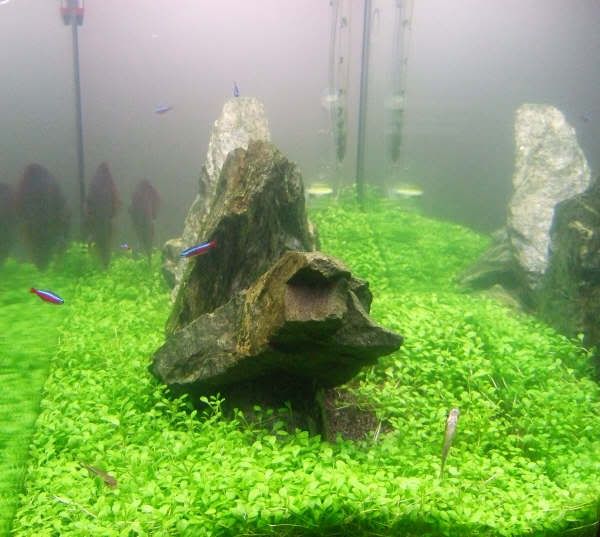
Glossostigma elatinoides is primarily used as a foreground plant in aquariums. When planting Glosso, making small clumps and placing them regularly is recommended to help the plants grow together more quickly.
Lighting is crucial for the successful growth of Glosso. It requires high-intensity lighting of at least 0.5 watts per litre to promote proper carpet formation. Insufficient lighting can cause Glosso to grow upwards instead of forming a dense carpet. It is essential to ensure that larger plants do not overshadow Glosso and block its access to light.
What Are Good Tank Mates?
When it comes to creating a harmonious and balanced aquarium ecosystem with Glossostigma elatinoides, it is vital to choose compatible tank mates. Selecting peaceful fish species that won’t disturb or damage the delicate Glossostigma carpet is crucial. Additionally, incorporating community aquarium plants that complement Glosso’s growth can enhance the overall aesthetics of your tank.
Good Tank Mates
Here are some small and peaceful fish species that can coexist with Glossostigma elatinoides:
- Neon Tetras
- Guppies
- Dwarf Rasboras
These fish are known for their calm temperament and compatibility with other species in a community tank. They are unlikely to cause any harm to the delicate Glosso carpet, allowing it to thrive and spread.
In addition to fish, shrimp can also serve as beneficial tank mates for Glossostigma elatinoides. For example, cherry shrimp and Amano shrimp can help maintain the cleanliness of the aquarium by consuming algae and other organic matter.
Fish Species To Avoid
While there are many suitable tank mates for Glossostigma elatinoides, it is crucial to steer clear of aggressive or larger fish species that may uproot or damage the Glosso carpet. These include:
- Oscars
- Cichlids
- Barbs
- Large predatory fish
These fish are known for their territorial behaviour or larger size, which can pose a risk to the delicate Glosso carpet. It is best to avoid introducing them to the same tank to ensure the well-being and growth of your Glossostigma elatinoides.
Feeding (Fertilization)
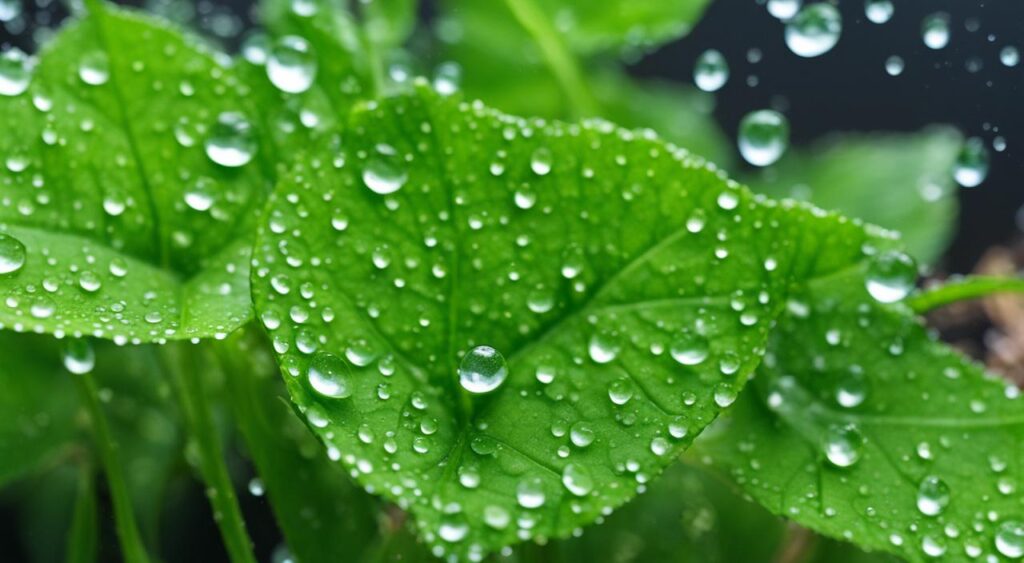
To provide optimal nutrition for Glossostigma elatinoides, it is recommended to use a comprehensive liquid fertilizer specifically formulated for aquarium plants. Glosso benefits from regular fertilization to support its growth and maintain vibrant colours.
The exact amount and frequency of fertilizer dosing will depend on the specific product used and the individual aquarium setup. It is essential to carefully follow the instructions provided by the manufacturer for accurate dosing. Regular water changes can also help replenish essential nutrients for the plants.
CO2 Injection
Glossostigma elatinoides benefit greatly from carbon dioxide (CO2) supplementation to promote healthy growth and prevent the plants from becoming leggy. CO2 injection supplies the necessary carbon for photosynthesis, ultimately enhancing the overall health and vitality of Glossostigma elatinoides plants in the aquarium.
Types of CO2 Injection
There are a variety of methods available for supplying CO2 to aquarium plants:
- Pressurized CO2 Systems: These systems utilize a gas cylinder, regulator, solenoid valve, and a diffuser or atomizer to provide a constant and controlled supply of CO2. The regulator allows for precise adjustment of the CO2 flow, while the diffuser or atomizer ensures even distribution of the CO2 throughout the aquarium water.
- DIY CO2 Systems: Some hobbyists prefer creating their CO2 systems using yeast, sugar, and water ingredients. These homemade systems may be less effective than pressurized systems but can still improve plant growth. DIY CO2 systems generally involve using a homemade reactor or diffuser to introduce CO2 into the aquarium water.
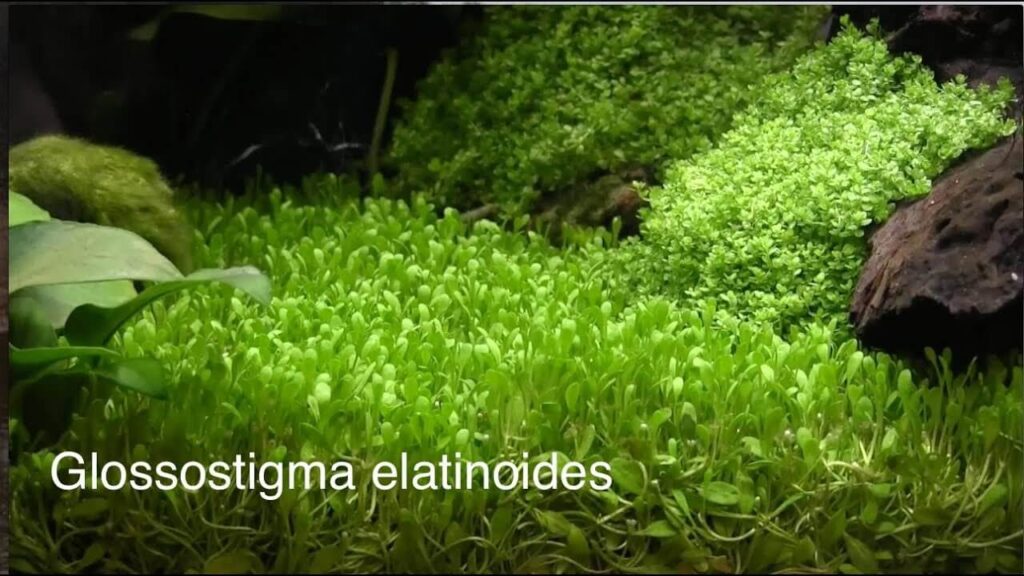
When selecting a CO2 injection method, it is crucial to consider the specific needs and requirements of your aquarium setup and your level of experience and expertise. Pressurized CO2 systems offer precise control and reliable results, while DIY systems can be a more cost-effective option for beginners.
Care
Planted Tank Parameters
Creating the ideal environment for Glossostigma elatinoides in your planted tank is crucial for its growth and overall well-being. Here are the key parameters to consider:
| Parameters | Optimal Range |
|---|---|
| Temperature | 22 to 28 degrees Celsius (72 to 82 degrees Fahrenheit) |
| pH | 6 to 7.5 (slightly acidic to neutral) |
| Hardness (KH) | 0 to 14°dKH (adaptation to a wide range of levels) |
| Nutrient Levels | Maintain appropriate nutrient levels through regular fertilization and monitoring |
Ensuring these parameters are within the optimal range provides the best conditions for Glossostigma elatinoides to thrive and achieve its vibrant growth.
Water Quality
Good water quality is essential for the health and development of Glossostigma elatinoides. Regularly monitor and maintain the following water parameters:
- Ammonia, nitrite, and nitrate levels should be kept at zero or low.
- Minimize fluctuations in temperature, pH, and hardness.
- Perform regular water changes to remove accumulated debris and maintain overall water quality.
Ensuring excellent water quality provides a stable and nurturing environment for Glossostigma elatinoides in your aquarium.
Filtration
Proper filtration is essential for the overall health and well-being of Glossostigma elatinoides. A reliable filtration system helps maintain optimal water parameters, removes debris and toxins, and promotes oxygenation. When choosing a filtration system, consider the specific needs of planted aquariums and ensure it provides adequate mechanical, chemical, and biological filtration.
Flow
Establishing an appropriate water flow in your aquarium is essential for the growth and health of Glossostigma elatinoides.
The right amount of flow helps distribute nutrients evenly and prevents the accumulation of debris. Avoid excessive flow that may uproot the plants or hinder their growth. Consider the layout and size of your aquarium when selecting a suitable water pump or adjusting the flow rate of your filtration system.
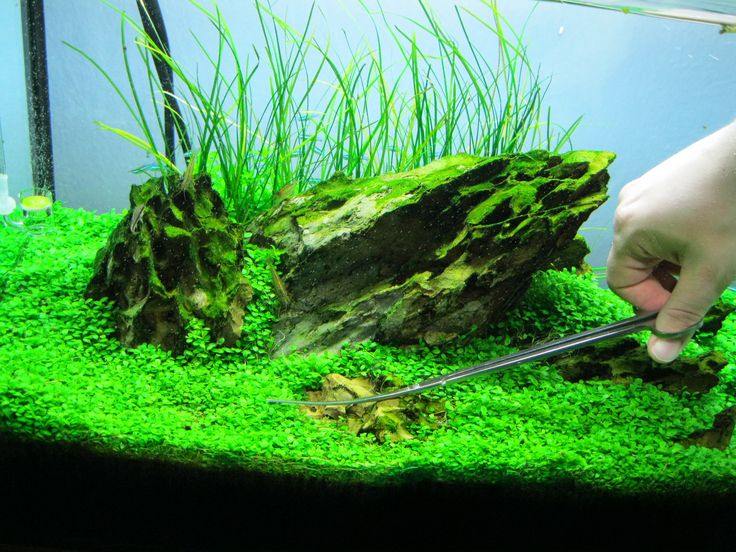
By paying attention to planted tank parameters, water quality, filtration, and flow, you can create an optimal environment for Glossostigma elatinoides and enjoy its lush green carpeting effect in your aquarium.
Aquarium Maintenance
Testing Water Conditions
Regularly testing the water parameters is essential to maintaining a healthy aquarium for both fish and plants. It allows you to monitor the vital aspects of water quality and ensure they are within the optimal range for the growth and well-being of your aquatic organisms.
When it comes to Glossostigma elatinoides, testing water conditions becomes even more crucial. This carpeting plant requires specific parameters to thrive, including pH, temperature, and nutrient levels. Regularly testing these parameters allows you to make any necessary adjustments to create an ideal environment for your Glosso carpet.
Test kits specifically designed for freshwater aquariums are readily available and provide accurate measurements of the water parameters. Follow the instructions supplied with the test kit to obtain reliable results. Take note of any deviations from the recommended values and take appropriate actions to address them.
How To Set Up Your Aquarium Tank
Properly setting up your aquarium tank is crucial for the long-term health and success of your Glossostigma elatinoides carpet. The following steps will guide you in creating an ideal environment for your Glosso:
- Choose a suitable aquarium tank size and shape based on your preferences and available space. Ensure it provides ample area for your Glosso carpet to spread and grow.
- Prepare the substrate by selecting a nutrient-rich option that promotes healthy plant growth. A fine-grained substrate, such as aquasoil or sand, works well for Glosso.
- Place a layer of fertilizer beneath the substrate to provide essential nutrients for your carpeting plants.
- Add hardscape elements like rocks or driftwood to create a natural aquascape and provide possible anchoring points for your Glosso.
- Fill the tank with dechlorinated water, ensuring the temperature matches your Glosso carpet’s preferred range.
- Install a reliable filtration system to maintain water quality and prevent the accumulation of debris that could hinder the growth of your Glosso.
- Introduce your Glossostigma elatinoides plants, separating and spreading them evenly across the substrate.
- Install a high-intensity lighting system that provides the necessary light for your Glosso to thrive.
- Monitor the water parameters regularly and adjust as needed to ensure they remain within the optimal range for Glosso.
Propagation Methods
Propagating Glossostigma elatinoides is an exciting and rewarding process, allowing you to expand your Glosso carpet. There are several methods you can employ to propagate this carpeting plant:
- Runners: Glosso spreads through runners, which are long, horizontal stems that develop along the substrate. These runners produce new plantlets that can be separated from the parent plant and replanted to create new colonies. Carefully detach the runners from the leading carpet and plant them in other aquarium areas.
- Trimming and Replanting: Regularly trimming your Glosso carpet encourages lateral growth and prevents vertical stretching. Cut the Glosso stems close to the substrate, leaving a minimum length of 1-2 cm. Replant the trimmed stems into the substrate, evenly spacing them to create a denser carpet.
By utilizing these propagation methods, you can expand your Glossostigma elatinoides carpet and achieve a lush and vibrant appearance in your aquarium.
Health And Disease
Signs Of Good Health
To ensure the health of Glossostigma elatinoides, it is essential to look out for the following signs of good health:
- Vibrant and lush green colouration
- Dense and compact growth
- New leaf growth from runners
- No signs of yellowing, browning, or wilting
Observing these signs in your Glossostigma indicates that the plant is receiving proper care and thriving in its environment.
Signs Of Poor Health
If your Glossostigma elatinoides is not in good health, there are sure signs that you should watch out for:
- Pale or yellow leaves
- Thinning or sparse growth
- Wilting or decaying leaves
- Stunted or leggy appearance
These signs can indicate that the plant is not receiving adequate light, nutrients, or carbon dioxide or that it may be suffering from an underlying health issue.
Common Health Issues And Treatment
Glossostigma elatinoides is generally a resilient plant, but it can still be susceptible to certain common diseases and health issues:
| Health Issue | Treatment |
|---|---|
| Brown spots or patches on leaves | Provide adequate lighting and address any nutrient deficiencies. Prune affected leaves as necessary. |
| Algae overgrowth | Maintain proper balance of light, nutrients, and carbon dioxide to prevent algae growth. Consider implementing algae-eating fish or invertebrates to help control algae. |
| Snail infestation | Manually remove snails from the aquarium. Consider adding snail-eating fish or employing snail control methods. |
Plant Pests
Glossostigma elatinoides can also be prone to certain plant pests that hinder its growth and overall health. Common plant pests that may affect Glossostigma include:
- Snails
- Algae
- Diatoms
Monitoring your aquarium regularly for signs of plant pests and taking appropriate measures to control their population is essential. This may include manual removal, implementing predator organisms, or employing pest control methods that are safe for aquatic plants and other inhabitants of the aquarium.
Summary
Glossostigma elatinoides, also known as Glosso, is a popular carpeting plant that can enhance the visual appeal of your aquarium. Glosso creates a dense and lush carpet effect with its vibrant green foliage and low-growing nature. However, to ensure its successful growth, providing the plant with the right conditions and care is crucial.
Proper lighting is crucial for Glosso to thrive. High-intensity lighting is necessary to encourage compact growth and prevent the plant from stretching upwards. CO2 supplementation is highly recommended to provide the plant with the necessary carbon for photosynthesis. Regular fertilization is also essential to supply Glosso with the nutrients it needs to maintain its lush appearance.

To maintain a healthy environment for Glosso, monitoring the water parameters, maintaining proper filtration, and ensuring adequate water flow are crucial. Regular testing of water conditions will help you make any necessary adjustments and keep the plant in optimal health. If signs of poor health or common plant pests occur, prompt action should be taken to address the issue.
By providing Glosso with the proper care and maintenance, you can create a stunning underwater landscape in your aquarium. With its vibrant colour, compact growth, and beautiful carpeting effect, Glossostigma elatinoides can highlight your aquatic display.
FAQ
What are the care requirements for Glossostigma elatinoides?
Glossostigma elatinoides requires high lighting, CO2 supplementation, and regular fertilization to thrive. It also benefits from regular water changes and monitoring of water parameters.
How do I plant Glossostigma elatinoides?
When planting Glosso, make small clumps and place them at regular intervals to help the plants grow together more quickly.
What is the ideal lighting for Glossostigma elatinoides?
Glossostigma elatinoides requires high-intensity lighting of at least 0.5 watts per liter to promote proper carpet formation.
What are good tank mates for Glossostigma elatinoides?
Small, peaceful fish species like neon tetras, guppies, and dwarf rasboras can coexist with Glossostigma elatinoides without causing any harm to the plants. Shrimp, such as cherry shrimp and Amano shrimp, can also be great companions for Glosso.
How often should I fertilize Glossostigma elatinoides?
Glossostigma elatinoides benefits from regular fertilization with a comprehensive liquid fertilizer specifically formulated for aquarium plants. The exact amount and frequency of fertilizer dosing will depend on the specific product used and the individual aquarium setup.
Why is CO2 supplementation important for Glossostigma elatinoides?
CO2 supplementation is important for Glossostigma elatinoides to provide the plants with the necessary carbon they need for photosynthesis. It helps promote healthy growth and prevents the plants from becoming leggy.
What are the water parameters for Glossostigma elatinoides?
Glossostigma elatinoides thrives in temperatures ranging from 22 to 28 degrees Celsius (72 to 82 degrees Fahrenheit) and prefers slightly acidic to neutral water conditions with a pH range of 6 to 7.5. It can adapt to a wide range of water hardness levels but prefers carbonate hardness (KH) between 0 and 14°dKH.
How do I test the water conditions for Glossostigma elatinoides?
Regularly test the water parameters, including pH, temperature, and nutrient levels, using test kits specifically designed for freshwater aquariums.
What are the signs of good health in Glossostigma elatinoides?
Signs of good health in Glossostigma elatinoides include vibrant and lush green coloration, dense and compact growth, new leaf growth from runners, and no signs of yellowing, browning, or wilting.
How do I propagate Glossostigma elatinoides?
Glossostigma elatinoides can be propagated through clippings or by allowing it to naturally spread through its creeping runners.
Note: Additional FAQs can be added based on the provided structure and relevant keywords.

